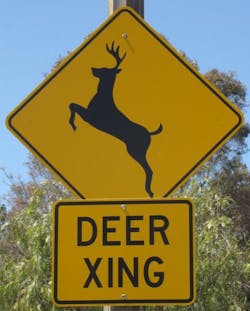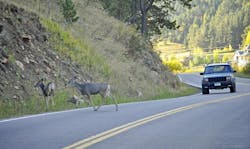Yet as I’ve noted before in this space, the potential for collisions between vehicles and deer more than doubles during October, November and December – the deer mating season – and in several states, that risk is now even higher, State Farm said.
For the eighth year in a row, West Virginia tops the list of states where vehicles might collide with deer, with the odds at one in 39 or nearly a 5% increase compared to 2013.
[Perhaps unsurprisingly, Hawaii ranks lowest for “deer crash risk” for the eighth year in a row with odds at one in 10,281. Indeed, State Farm said Hawaiians are three times more likely to get struck by lightning in their lifetime than they are to hit a deer in the next year.]
Interestingly, the insurance company’s research indicated that deer collisions increased by more than 21% in Indiana and more than 8 % in Virginia this year, with 2014 marking the first year South Carolina made it on the “top 10 list” for deer-crash risk, with drivers in the Palmetto state facing a one in 93 chance of colliding with a deer.
State Farm pinged Ron Regan, executive director for the Association of Fish & Wildlife Agencies, to provide a little insight into some of the reasons behind higher rates of deer-involved crashes, especially during the fall.“Periods of daily high-deer movement around dawn and dusk as well as seasonal behavior patterns, such as during the October-December breeding season, increase the risk for auto-deer collisions,” he explained.
“Changes in collision rates from year to year are a reflection of changing deer densities or population levels – more deer in a given area increases the potential for collision,” Regan added. “Deer populations are also affected by conditions such as new or improved roads with higher speeds near deer habitat, changes to hunting seasons to manage wildlife, winter conditions, and other related factors.”
It should also be noted that collisions with animals can lead to traffic fatalities. In 2012, for instance, some 175 deaths were the result of collisions with animals, with deer being the animal most often struck, according to the Insurance Information Institute and the Insurance Institute for Highway Safety.
Here are a few more findings from State Farm’s annual “deer crash” research:
- The months a driver is most likely to collide with a deer in the U.S. ranked in order are: November, October, and December.
- About 10% the country’s deer collisions occur in Pennsylvania (123,941 collisions) though when taking into account the amount of licensed drivers in the state, West Virginia still edges out as number one with a likelihood of one in 39 compared to Pennsylvania’s one in 71, which is ranked number two.
- Dusk and dawn are the highest risk times for striking a deer.
- There are about 1.5 million animal-car accidents each year that cause an average of 10,000 injuries, 150 deaths, and an average of $2,500 in property damage.
Tips to keep in mind as the temperatures begin to dip, the leaves begin to fall, and more deer are on the move.


